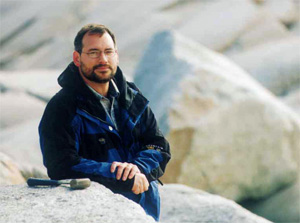 |
| John Gosse created the popular Earthquakes, Volcanoes and Other Natural Disasters for non-science majors. |
Chiccckkkk!
Glug, glug, glug.
There’s nothing like cracking open a can of beer at 8:30 in morning to get the attention of university students.
John Gosse, associate professor with the Department of Earth Sciences, pours out the amber brew in a clear jug so it has a nice, thick head. It’s projected on the big screen so everyone in the auditorium can see clearly.
But he’s not about to drink it. Instead, he’s going to measure the thickness of the froth and the rate at which it dissipates over time. It’s just the coolest way to illustrate the concept of exponential relationships. The head disappears at an exponential rate, which is not unlike the decay of a radioactive mass or the rate of heat loss from the earth since its formation: many natural systems change rapidly at first and then more gradually with time.
“Once they see it illustrated this way, the concept will never leave them,” says Dr. Gosse, who teaches Earthquakes, Volcanoes and Other Natural Disasters (ERTH 1060). “When I hear students talking about it when they leave the class, I know I’ve got them interested.”
Canada Research Chair in Earth System Evolution, Dr. Gosse created the popular class specifically for non-Earth Science majors. It explores all kinds of natural phenomena, including meteorite impacts, rapid climate change, hurricanes, landslides, solar flares and floods. Besides discussing the where, how and why of natural disasters, students delve into the human and economic impacts.
“The subject is really fun. We don’t get bogged down deeply into many equations for some wave … the material is active, current and very social. Examining the societal impact is very important.
“When you take a look at something like the (Boxing Day) tsunami of 2004, for example, and see that 250,000 people died, you can really see the human impact.”
Whenever he can, Dr. Gosse uses examples from Atlantic Canada and contemporary disasters to assess local risk and explore phenomenon. Last term, for example, students learned all about Post-Tropical Storm Noel: about how it began as Caribbean depression, pounded Cuba, the Dominican Republic, Haiti, the Bahamas and Jamaica, and then headed for the Atlantic provinces in a reduced state. Even so, Noel drenched Halifax with 53 mm of rain and whipped it with 113-km winds.
The first-year survey class is quite different from other classes taught in the Department of Earth Sciences, which tend to be much smaller and more hands-on. Dr. Gosse also teaches a fourth-year class, Geomorphology and Landscape Evolution (ERTH 4440) and classes for incoming graduate students, including Research Design and Scientific Presentation (ERTH 6300) and Geochronology and Thermochronology (ERTH 6400). That’s in addition to his research which focuses on geochronology and determining rates of glacial, fluvial (flowing water) and tectonic processes.
Being so much larger, with about 400 students, Natural Disasters calls for some imaginative teaching. As the course expanded, geophysicist Charlie Walls joined Dr. Gosse to co-instruct and improve the IT. They’ve been known to play clips from disaster movies (Dante’s Peak and Supervolcano from the Discovery Channel), pass around chunks from meteorites and pull out a slinky and skipping rope to illustrate seismic waves generated by earthquakes.
“I’ve always been fascinated by major catastrophic events in the Earth’s record,” says Dr. Gosse. “I think we know only so much about the skin of the apple and the processes that are triggered by what’s going on well below the skin.
“I’m just in awe.”
